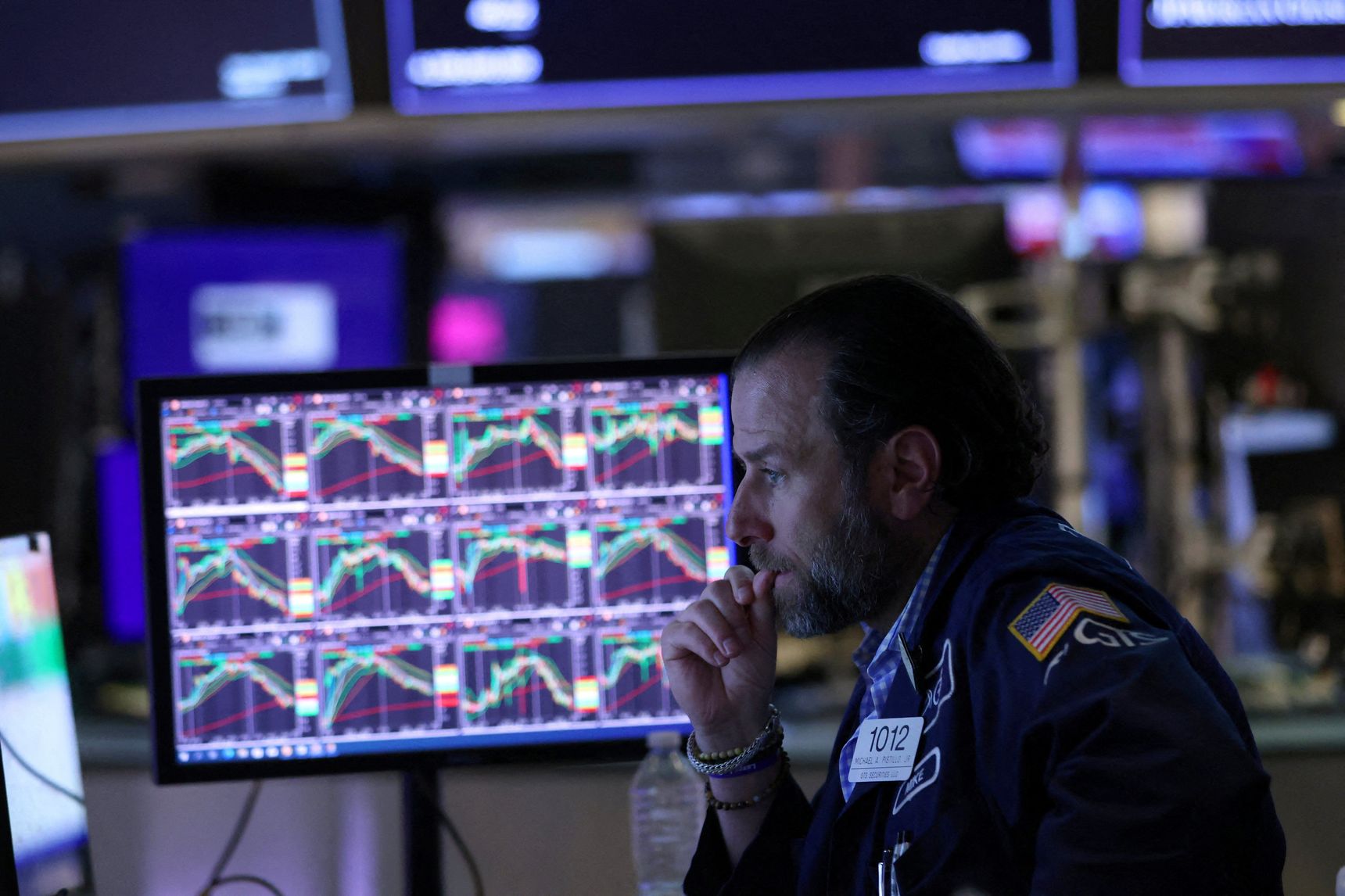Where to Look for the Next Wall Street Blowup
The tide’s definitely gone out in markets this year, but finance has come through with few problems—so far.
When the tide goes out you find out who was swimming naked, Warren Buffett memorably said. The tide’s definitely gone out in markets this year, but finance has come through with few problems. Is it possible that this time not many were skinny-dipping?
The optimistic view is that the typical culprits—speculators using borrowed money—had been caught out already in the past two years and so weren’t up to their usual tricks. The pessimistic view is that the blowups are still to come.
Start with the positive: the list of recent crises that made investors reassess the dangers. The shock of the pandemic in early 2020revealed serious problems with leveraged trading and overnight borrowing in Treasurys. The Federal Reserve stepped in and backstopped the market, but fixed-income hedge funds that lost big as Treasurys moved in the wrong direction cut back.
In January 2021, short sellers were hit as Redditors piled into meme stocks such as GameStop, driving up their prices and causing multibillion-dollar losses for those betting against them. Melvin Capital, which was heavily short GameStop, finally shut down this year. Other hedge funds took note, and concentrated short positions were rethought.
Then in March last year—when the market was still super-bullish—hedge fund Archegos blew up, causing US$10 billion or so of losses to investment banks that had unwisely lent it money. Soul-searching at the investment banks means they have re-examined their hedge-fund lending, while Credit Suisse decided to pull out of the business altogether. Again, greater powers given to risk managers mean there is less risk of a repeat.
Roll forward to the autumn and currency and bond traders began preparing for rate rises, led by surprisingly hawkish talk from the Bank of England. But prices snapped back abruptly in November when the Bank didn’t follow through with the expected tightening, again giving funds that trade on macroeconomic news a dry run for the volatility that has dominated markets globally since.
All of these big but not huge shocks helped ensure that risk-taking was cut back, meaning there were fewer highly leveraged players who might be taken out by the extreme moves of 2022 in stocks, bonds, commodities and currencies.
So far there has been only one true catastrophe in traditional finance, the freezing of the nickel market when the London Metal Exchange foolishly decided to save a Chinese firm caught out by massive wrong-way bets. But bad as that was, it was never going to be enough to take down important parts of the financial system.
There have been some total disasters in crypto, notably the collapse of the Terra “stablecoin,” but the links to traditional finance remain small enough that this matters little to the mainstream.
The other important pillar of support is that banks are significantly stronger than in the past couple of decades, thanks to post-2008 reforms. They can weather bad times more easily as a result.
So much for the good news. The prevailing mood of finance executives I’ve asked about the lack of trouble is summed up by a repeated response: “So far.”
Long before Mr. Buffett discussed naked swimmers, economist John Kenneth Galbraith invented the “bezzle”—fraudulent losses accumulated in the good times that are only discovered when the economy weakens. After a decadelong bull market with only the briefest of interruptions in 2020, there could be plenty of bezzles yet to emerge.
The biggest bezzles in recent history took painfully long to emerge. After the bursting of the dot-com bubble in March 2000, it was 18 months before accounting fraud took down power company and leveraged energy trader Enron in what was then the biggest-ever bankruptcy. After the 2008 financial crisis, scandals continued for years across both finance and real-economy businesses.
The feedback loop from finance to the real economy and back to finance takes time to create serious problems, too. Already the weakest and most indebted developing countries are in trouble, with Sri Lanka in crisis and Ghana imposing fierce austerity to keep finances in order. The rising dollar and higher U.S. bond yields hurt governments and countries that chose to borrow in dollars and have a mismatch of dollar costs and local-currency income.
In 1994 and 1997-1998, it took more than a year for emerging-market crises—in 1994 Mexico’s “Tequila crisis,” in 1997 the Asian devaluations followed by Russia’s domestic-debt default—to feed back to Wall Street. When they did, Wall Street’s financial stability wobbled. More worryingly, the loss for investors in benchmark 10-year Treasurys from their peak is already much bigger than the shock of 1994.
There are two new risks that history doesn’t help with. The first is the unprecedented amount of liquidity that has been pumped into finance by central banks buying bonds. A lack of liquidity is what usually creates financial problems, as it prevents debts being rolled over. As the Fed and other central banks drain liquidity, problems might reveal themselves.
The second is that there’s a massive, and unknown, amount of private debt issued by lightly regulated shadow banks. My worry isn’t mainly that the lending turns sour (although it might). Rather, the danger is that the private-debt boom turns out to be a function of easy money. If investors prove less willing to lock up their money in private-debt funds as interest rates make mainstream investments more attractive, there will be a steady withdrawal of lending capacity. That could hold back the economy and make it harder for companies to refinance loans. These sorts of knock-on effects could take years to feed through into financial trouble.
I suspect there are plenty of underdressed bathers still to be exposed. I hope the crisis practice runs of the past two years mean there is less risk of Wall Street coming to a sudden stop.
Reprinted by permission of The Wall Street Journal, Copyright 2021 Dow Jones & Company. Inc. All Rights Reserved Worldwide. Original date of publication: May 31, 2022.
 Copyright 2020, Dow Jones & Company, Inc. All Rights Reserved Worldwide. LEARN MORE
Copyright 2020, Dow Jones & Company, Inc. All Rights Reserved Worldwide. LEARN MORE
This stylish family home combines a classic palette and finishes with a flexible floorplan
Just 55 minutes from Sydney, make this your creative getaway located in the majestic Hawkesbury region.
Continued stagflation and cost of living pressures are causing couples to think twice about starting a family, new data has revealed, with long term impacts expected
Australia is in the midst of a ‘baby recession’ with preliminary estimates showing the number of births in 2023 fell by more than four percent to the lowest level since 2006, according to KPMG. The consultancy firm says this reflects the impact of cost-of-living pressures on the feasibility of younger Australians starting a family.
KPMG estimates that 289,100 babies were born in 2023. This compares to 300,684 babies in 2022 and 309,996 in 2021, according to the Australian Bureau of Statistics (ABS). KPMG urban economist Terry Rawnsley said weak economic growth often leads to a reduced number of births. In 2023, ABS data shows gross domestic product (GDP) fell to 1.5 percent. Despite the population growing by 2.5 percent in 2023, GDP on a per capita basis went into negative territory, down one percent over the 12 months.
“Birth rates provide insight into long-term population growth as well as the current confidence of Australian families,” said Mr Rawnsley. “We haven’t seen such a sharp drop in births in Australia since the period of economic stagflation in the 1970s, which coincided with the initial widespread adoption of the contraceptive pill.”
Mr Rawnsley said many Australian couples delayed starting a family while the pandemic played out in 2020. The number of births fell from 305,832 in 2019 to 294,369 in 2020. Then in 2021, strong employment and vast amounts of stimulus money, along with high household savings due to lockdowns, gave couples better financial means to have a baby. This led to a rebound in births.
However, the re-opening of the global economy in 2022 led to soaring inflation. By the start of 2023, the Australian consumer price index (CPI) had risen to its highest level since 1990 at 7.8 percent per annum. By that stage, the Reserve Bank had already commenced an aggressive rate-hiking strategy to fight inflation and had raised the cash rate every month between May and December 2022.
Five more rate hikes during 2023 put further pressure on couples with mortgages and put the brakes on family formation. “This combination of the pandemic and rapid economic changes explains the spike and subsequent sharp decline in birth rates we have observed over the past four years,” Mr Rawnsley said.
The impact of high costs of living on couples’ decision to have a baby is highlighted in births data for the capital cities. KPMG estimates there were 60,860 births in Sydney in 2023, down 8.6 percent from 2019. There were 56,270 births in Melbourne, down 7.3 percent. In Perth, there were 25,020 births, down 6 percent, while in Brisbane there were 30,250 births, down 4.3 percent. Canberra was the only capital city where there was no fall in the number of births in 2023 compared to 2019.
“CPI growth in Canberra has been slightly subdued compared to that in other major cities, and the economic outlook has remained strong,” Mr Rawnsley said. “This means families have not been hurting as much as those in other capital cities, and in turn, we’ve seen a stabilisation of births in the ACT.”
This stylish family home combines a classic palette and finishes with a flexible floorplan
Just 55 minutes from Sydney, make this your creative getaway located in the majestic Hawkesbury region.






















